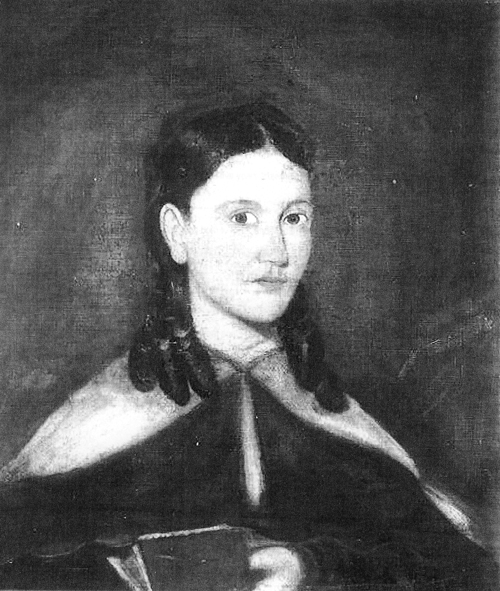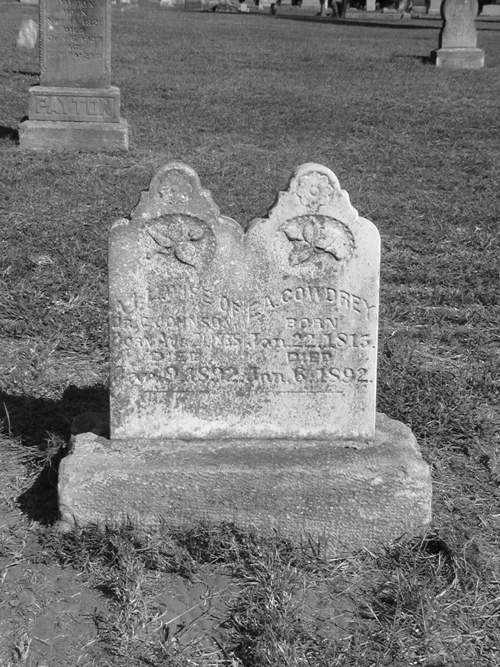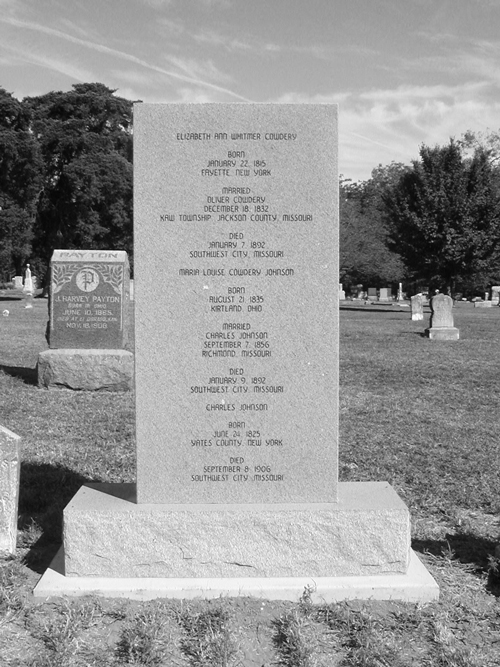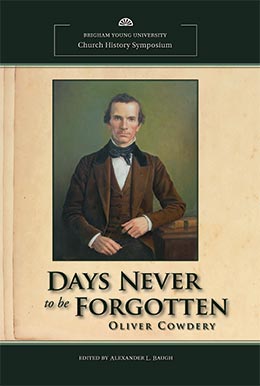Elizabeth Ann Whitmer Cowdery: A Historical Reflection of Her Life
Ronald E. Romig
Ronald E. Romig, “Elizabeth Ann Whitmer Cowdery: A Historical Reflection of Her Life,” in Days Never to Be Forgotten: Oliver Cowdery, ed Alexander L. Baugh (Provo, UT: Religious Studies Center, Brigham Young University, 2009), 327–38.
Ronald E. Romig served as the Community of Christ Archivist in Independence, Missouri, when this was published.
 Portrait of Elizabeth Ann Whitmer Cowdery, wife of Oliver Cowdery. This painting is believed to have been painted in 1837 as part of a series of portraits of the Presidents of the Church and their wives, and it was intended to hang in the Kirtland Temple. Oliver Cowdery may have brought the portrait when the family moved from Kirtland to Far West in late 1837. (By permission of the Community of Christ Museum, Independence, Missouri.)
Portrait of Elizabeth Ann Whitmer Cowdery, wife of Oliver Cowdery. This painting is believed to have been painted in 1837 as part of a series of portraits of the Presidents of the Church and their wives, and it was intended to hang in the Kirtland Temple. Oliver Cowdery may have brought the portrait when the family moved from Kirtland to Far West in late 1837. (By permission of the Community of Christ Museum, Independence, Missouri.)
Peter and Mary Whitmer and their family moved from Pennsylvania to New York around 1808, so Elizabeth Ann Whitmer’s family was well settled and relatively prosperous by the time she joined the family on the Whitmer farm in Fayette Township, Seneca County, New York, on January 22, 1815.[1] Her birth order made her the youngest child of a large and active extended family. There was no lack of love and attention for this welcome addition to the Whitmer household.
Elizabeth’s early childhood must have seemed safe and orderly, well patterned around a rich religious tradition and filled with the wise love of older parents. Her older siblings and extended family must have seemed like extra sets of parents—her older brothers, Christian and Jacob, having married when she was around ten years old. Her brother Jacob and his wife, Elizabeth, lived in the old Whitmer cabin in the yard next to the family’s snug log home. It must have been comforting to be around her aunts Anna and Elizabeth, who no doubt looked upon young Elizabeth as if she could be their own.
Early Experiences
Elizabeth was about fourteen years old when Joseph and Emma Smith moved to the Whitmer farm to work on the translation of the Book of Mormon. These teen years must have been a constant wonder to her as she was present during these remarkable and extraordinary events. Imagine Elizabeth approaching her young womanhood, yet very much still a child, exploring the hidden recesses of her home where the young Smith family lived. She must have many times crept up the steps to peek into the chamber wondering what strange business was going on there, while Joseph, Oliver, Christian, John, and others were translating, writing out revelations, or entertaining visitors. So it was not altogether by choice that Elizabeth Ann became part of the Mormon story, but it was in response to the experiences of her family, parents, brothers, and sister Catharine, and also later by marriage.
To the Whitmers, early Mormonism was a world full of angelic appearances and miracles. One such story involving angels was told and retold in the Whitmer family. It is shared here in the words of Helen Van Cleave Blankmeyer, David Whitmer’s great-granddaughter:
When Peter [Whitmer Sr.] heard David planning to go off to meet Oliver [and Joseph Smith in Harmony], and in mid-week too, he protested: “Na, na,—not till the south field is harrowed and the plaster spread! That is your job, as you know, and it will not take less than two full days, maybe more. Duty first, duty first.” David agreed, but he was sad, and the little Elizabeth . . . grieved for her brother’s disappointment. She watched him through the next day as he drove the harrow hard, his long body and broad shoulders contesting with the earth as with a strong wrestler, but at evening the task was scarcely half done. Rising early on the second day to prepare his breakfast, she stepped into the yard and glanced toward the field. To her amazement it was all evenly harrowed, and the lime neatly spread, while two strange men, just visible through the morning mist, were leaving the place at the far side. David came out of the house, and stood entranced beside her. “Elizabeth? . . . Elizabeth! . . . It must be, it can only be. . . .” “Yes,” she breathed, . . . “angels.”[2]
Marriage to Oliver
After the Church was organized, Elizabeth became one of its earliest members. Following a meeting of the Church in Fayette on April 18, 1830, Oliver baptized Elizabeth, and she would later become his wife.[3]
The Whitmer family followed Joseph Smith and the religion he founded to Ohio and then moved on to the Church’s colony in western Missouri. It is little wonder that Oliver Cowdery was attracted to Elizabeth and eventually sought her hand in marriage. David’s Whitmer’s great-granddaughter, Helen Van Cleave Blankmeyer, described Elizabeth Ann Whitmer as “a tiny bird-like creature, sympathetic, practical, resourceful, and a fountain of fun.”[4]
So it was, then, on the very western edge of the United States, that Oliver and Elizabeth Ann were married in Kaw Township, Jackson County, Missouri, by Parley P. Pratt on December, 18, 1832.[5] Elizabeth left her parents’ family home in Kaw Township, to join her husband in Independence to be near his work in the Church printing office.
On July 20, 1833, Elizabeth watched safely from the side as a group of angry nonmember citizens of Jackson County tore down the print shop. Moments before, she must have urged Oliver and others to discreetly step a little out of the way for their own safety. As a result of the disruption of the press, seven laborers lost their jobs and “three families including Oliver and Elizabeth [were] left destitute of the means of subsistence.”[6] Because of this disaster, Oliver immediately traveled to Ohio, while Elizabeth Ann returned to stay with her folks in the Whitmer settlement. Oliver remained in Ohio for an extended period. Elizabeth eventually rejoined him after the expulsion of the Saints from Jackson County.
While in Kirtland, Oliver and Elizabeth had a daughter born to them. Maria Louise (sometimes Louisa) Cowdery, born August 21, 1835, was their only child to live to maturity. [7] Five others of their children died in infancy or early childhood.[8]
Oliver and Elizabeth were in Kirtland to share in the marvelous events associated with the dedication of the Kirtland Temple. During this time Oliver assisted with printing the Doctrine and Covenants, Emma’s hymnal, and a second edition (1837) of the Book of Mormon, on which Oliver set the type. The long hours he devoted to this responsibility often kept him from family matters. When the book was finally completed, Oliver had a copy especially bound in lovely red Moroccan leather binding with Elizabeth’s name embossed across the front in gold lettering. One can easily imagine Oliver affectionately presenting this book to his wife as a kind of peace offering. He shared the precious symbol of his work with Elizabeth in hopes she would understand and forgive his many long hours away from the family. Today, Elizabeth Ann’s personal copy of the 1837 edition of the Book of Mormon may be seen at the Community of Christ’s Kirtland Temple Visitors Center Museum, Kirtland Ohio.
On December 5, 1834, Oliver Cowdery was ordained the Assistant President of the Church.[9] Sometime following the dedication of the Kirtland Temple, a series of portraits of the Church Presidents who had participated in the dedication, and their wives, was envisioned as an embellishment to the temple. Extant portraits from this series appear to date around 1837. Documentary sources suggest that the portraits were completed and hung for a time in the temple, including the portraits of Oliver and Elizabeth. The Cowderys remained in Kirtland through mid-1837.
Move to Missouri
As the family prepared to move to Far West, Missouri, Oliver and Elizabeth’s portraits were crated for shipment to Missouri. The Cowdery family moved to upper Missouri sometime before early November 1837. Oliver initially purchased land three miles south of the new settlement of Saints in Caldwell County, but he and Elizabeth Ann joined the Whitmers in making their home in Far West.[10] Writing to his brother Warren in January 1838, Oliver indicated, “My family are about as usual. We [are] a part of bro. J[ohn] W[hitmer]’s house and expect to be till spring.”[11] At Far West, Cowdery served as clerk of the high council and general Church recorder.
Joseph Smith’s arrival in Far West in March 1838 seemed to stir what had been largely administrative disagreements into open acts of violence focused against those perceived as dissenters. In June, Cowdery was ordered to leave the county within three days or suffer the consequences.[12] John Whitmer’s history explains:
They commenced suing at the law of the land by attachment for debts which they knew were paid . . . against David Whitmer, L. E. Johnson, O. Cowdery, F. G. Williams W. W. Phelps and myself [we] went to Clay Co. to obtain legal counsel to prepare to overthrow these attachments which they had caused to be issued against us which we were abundantly able to do by good and substantial witnesses
But to our great astonishment when we were on our way home from Liberty Clay Co. we met the families of O. Cowdery and L. E. Johnson whom they had drive from their homes and robed [sic] them of all their goods save clothing & bedding, &c.[13]
Departing Far West in haste, extended members of the Whitmer family ended up in Richmond, Missouri, in search of personal safety and to consider possible legal remedies.[14] Other family members, left behind initially, shortly joined them.[15] Thereafter, they established homes in Richmond, Missouri.
Return to Ohio
After a short period, Oliver and Elizabeth and their family moved back to Ohio. They returned to the Kirtland area for a time, where Oliver found employment as a lawyer, then moved to Tiffin, Ohio, for several more years. During these years, the Cowderys received word of the death of their former friend Joseph Smith Jr.
In 1849, Oliver traveled to the Council Bluffs area and was rebaptized. Oliver and Elizabeth rejoined the Whitmers in Richmond, where Oliver died in 1850. Elizabeth and her daughter Julia Ann remained for the next few years in Richmond, living in a room in the Peter Sr. and Mary Whitmer home.
The paintings of Oliver and Elizabeth mentioned earlier in this reminiscence passed into the hands of John Whitmer and remained in the family for many years. They were still in John Whitmer’s farm house at Far West, Missouri, throughout the 1920s. The paintings came into the possession of the RLDS Church in 1930 and survive to this day. Elizabeth’s and Oliver’s portraits are often on display in the museum at the Community of Christ Temple, in Independence, Missouri.
Many valuable historical papers of the early Church movement also passed into the care and keeping of David Whitmer after Oliver’s death. David became the steward of the precious printer’s copy of the Book of Mormon manuscript that Oliver had retained and protected since the beginning of the work in the state of New York more than twenty years before; also a copy of the “C[h]aracters” from the book of Book of Mormon plates, Book of Commandment manuscript revelations, which Oliver had carried to Missouri in 1831 for publication by the Church’s Literary Firm; and manuscripts of Joseph Smith’s revision of the Bible in which Oliver had assisted as a scribe. These artifacts of the early Church were acquired by the RLDS Church in 1903 from David Whitmer’s grandson George Schweich.
Elizabeth and her daughter Maria Louise lived in a room of the Peter and Mary Whitmer home in Richmond for several years. After Maria married Charles Johnson, a young medical doctor, Elizabeth joined them in Colorado. Years later, the family moved to Southwest City, Missouri, where Charles continued to practice as a doctor.
Mother Elizabeth and daughter Maria Louise died within days of each other and are still together, buried beside each other in the Southwest City burial ground.[16]
 Elizabeth Ann Whitmer Cowdery, Maria Louise Cowdery Johnson, and Charles Johnson memorial (back side), Southwest City Cemetery, Southwest City, Missouri (2006). Photograph by Alexander L. Baugh. The inscription on the back side of the memorial reads: Elizabeth Ann Whitmer Cowdery was born at Fayette, New York, January 22, 1815. She was baptized a member of the restored Church of Christ on April 18, 1830, twelve days after its organization. In 1832 she married Oliver Cowdery, who testified he saw the gold plates from which the Book of Mormon was translated, and the angel Moroni, who delivered the plates to Joseph Smith. A friend called Elizabeth “a beautiful woman” with a “kind disposition.” Maria Louise Cowdery Johnson, the oldest and only child of Oliver and Elizabeth who grew to adulthood, was born at Kirtland, Ohio, on August 21, 1835. In 1856 she married Charles Johnson, whose grave is nearby. Her obituary called her “a genial friend and neighbor.” Mother and daughter were inseparable in life and death. Elizabeth lived with the Johnsons for thirty-five years. Elizabeth and Maria died just days apart. To the end, both believed in the divine revelation of the Book of Mormon. Erected by the Mormon Historic Sites Foundation. October 8, 2006. (Photograph by Alexander L. Baugh, 2006)
Elizabeth Ann Whitmer Cowdery, Maria Louise Cowdery Johnson, and Charles Johnson memorial (back side), Southwest City Cemetery, Southwest City, Missouri (2006). Photograph by Alexander L. Baugh. The inscription on the back side of the memorial reads: Elizabeth Ann Whitmer Cowdery was born at Fayette, New York, January 22, 1815. She was baptized a member of the restored Church of Christ on April 18, 1830, twelve days after its organization. In 1832 she married Oliver Cowdery, who testified he saw the gold plates from which the Book of Mormon was translated, and the angel Moroni, who delivered the plates to Joseph Smith. A friend called Elizabeth “a beautiful woman” with a “kind disposition.” Maria Louise Cowdery Johnson, the oldest and only child of Oliver and Elizabeth who grew to adulthood, was born at Kirtland, Ohio, on August 21, 1835. In 1856 she married Charles Johnson, whose grave is nearby. Her obituary called her “a genial friend and neighbor.” Mother and daughter were inseparable in life and death. Elizabeth lived with the Johnsons for thirty-five years. Elizabeth and Maria died just days apart. To the end, both believed in the divine revelation of the Book of Mormon. Erected by the Mormon Historic Sites Foundation. October 8, 2006. (Photograph by Alexander L. Baugh, 2006)
 Original grave marker for Elizabeth Ann Whitmer Cowdery and Maria Louise Cowdery Johnson, Southwest City Cemetery, Southwest City, Missouri (2006). The two women died two days apart from each other. Photograph by Alexander L. Baugh.
Original grave marker for Elizabeth Ann Whitmer Cowdery and Maria Louise Cowdery Johnson, Southwest City Cemetery, Southwest City, Missouri (2006). The two women died two days apart from each other. Photograph by Alexander L. Baugh.
Notes
[1] Whitmer family Bible, Family Record, Community of Christ Library-Archives, Independence, Missouri.
[2] Helen Van Cleave Blankmeyer, David Whitmer: Witness for God, Written for His Descendants (n.p., 1955), 7; Community of Christ Archives, Independence, Missouri.
[3] The following were baptized on April 18, 1830, by Oliver Cowdery: Peter Whitmer Sr., Mary M. Whitmer, William Jolly, Elizabeth Jolly, Vincent Jolly, Richard B. [Ziba] Peterson, and Elizabeth Ann Whitmer. (Joseph Smith, History of the Church of Jesus Christ of Latter-day Saints, ed. B. H. Roberts, 2nd ed. rev. [Salt Lake City: Deseret Book, 1971], 1:81).
[4] Helen Blankmeyer, David Whitmer, 8.
[5] See Scott H. Faulring, “Early Marriages Performed by the Latter-day Saint Elders in Jackson County, Missouri, 1832–1834,” Mormon Historical Studies 2, no. 2 (Fall 2001): 197–210. Faulring provides a photograph of Oliver and Elizabeth’s marriage certificate on page 201.
[6] The Evening and the Morning Star, December 1833, 114.
[7] Mary Bryant Alverson Mehling, Cowdrey-Cowdery-Cowdray: William Cowdery of Lynn, Massachusetts, 1630, and His Descendants (New York: F. Allaben Genealogical Company, 1911), 173; and Mary Cleora Dear, Two Hundred Thirty-Eight Years of the Whitmer Family, 1737–1976 (Richmond, Missouri: Beck Printing Company, 1976), 48; give Maria’s birth date as August 11, 1835. However, in “Genealogy of President Oliver Cowdery” in Joseph Smith’s History, 1834–1836, it states that Maria was actually born on August 21, 1835. Note the following entry: “Maria Cowdery was born in Kirtland, Geauga County, Ohio, fifteen (15) minutes past 9 o’clock a.m. Friday, August 21, 1835” (Dean C. Jessee, ed., The Papers of Joseph Smith, 2 vols. [Salt Lake City: Deseret Book, 1989–1992], 1:19). Since the manuscript is in the handwriting of Oliver, it would appear to be a more accurate date.
[8] Dear, Two Hundred Thirty-Eight Years of the Whitmer Family, 48.
[9] See Jessee, Papers of Joseph Smith, 1:20–22; 2:36.
[10] Cowdery entered 160 acres of land in Sections 26 and 36, Mirabile Township, in 1836. See Clark V. Johnson, ed., An Index to Early Caldwell County, Missouri Land Records (n.p., n.d.), 30.
[11] Oliver Cowdery to Warren Cowdery, January 21, 1838, Oliver Cowdery Letter Book, Huntington Library, San Marino, California.
[12] Ebenezer Robinson, “Items of Personal History of the Editor,” The Return 1, no. 10 (October 1889): 146.
[13] Bruce N. Westergren, ed., From Historian to Dissident: The Book of John Whitmer (Salt Lake City: Signature Books, 1995), 184. John Whitmer’s manuscript history passed to the RLDS Church (now the Community of Christ) in 1903.
[14] See Jessee, Papers of Joseph Smith, 2:249.
[15] Robinson, “Items of Personal History of the Editor,” 147.
[16] See Alexander L. Baugh, “Separated from Oliver in Death: The Elizabeth Ann Whitmer Cowdery Memorial Dedication,” Mormon Historical Studies 7, nos. 1–2 (Spring–Fall 2006): 115–23.
